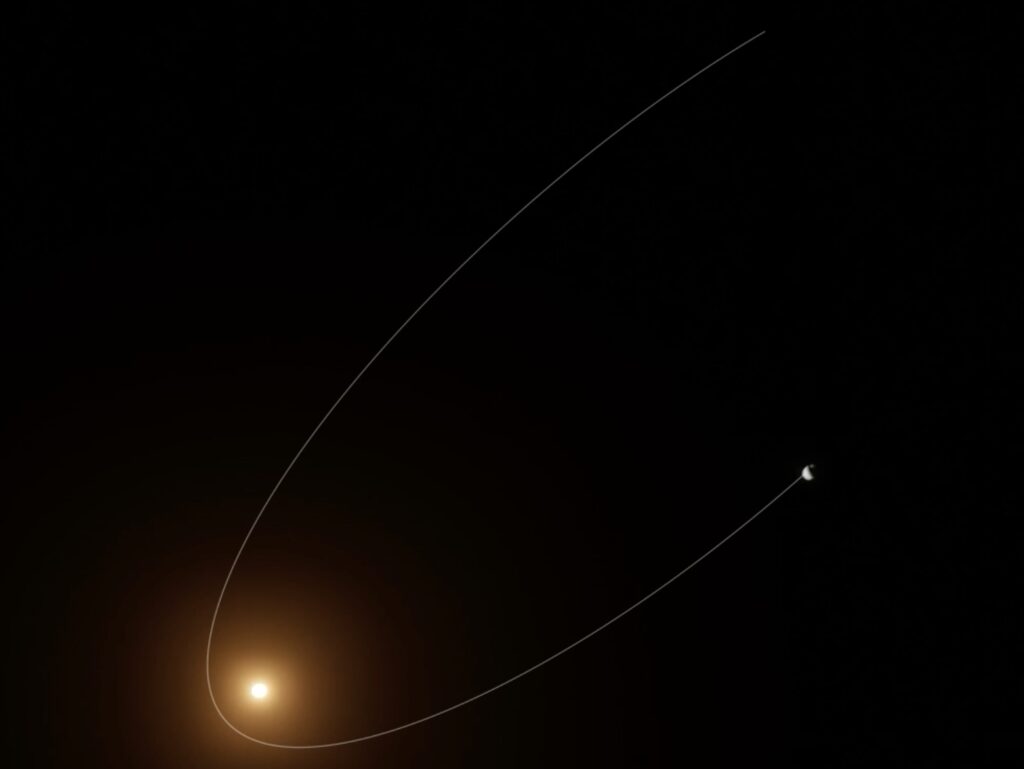Astronomers at Penn State University have identified an exoplanet with the most eccentric orbit ever observed among transiting planets, making it quite “wacky” compared to other exoplanets.
Named TIC 241249530, this newly discovered exoplanet exhibits a highly elongated orbit resembling a cucumber rather than a circle. Published in the journal Nature, the study provides significant insights into the formation and evolution of Hot Jupiters, a class of massive gas giants that orbit very close to their host stars.
“We caught this massive planet making a sharp, hairpin turn during its close passage to its star,” paper author and Penn State Professor Suvrath Mahadevan said in a press release. “Such highly eccentric transiting planets are incredibly rare — and it’s really amazing that we were able to discover the most eccentric one.”
First detected using NASA’s Transiting Exoplanet Survey Satellite (TESS) in January 2020, the exoplanet’s host star exhibited a dip in its brightness, indicating the presence of a Jupiter-sized planet passing in front of it. Subsequent observations using the NEID and Habitable Zone Planet Finder spectrographs confirmed the planet’s extreme orbital characteristics.
Astronomers knew they had spotted something quite unique. The planet’s orbit has an eccentricity of 0.94, surpassing the eccentricity of any other known transiting exoplanet. For comparison, Earth’s orbit has an eccentricity of 0.02, and Pluto’s is 0.25.
Moreover, the planet is moving backward.


(Image: Abigail Minnich/Penn State)
TIC 241249530’s orbit is in retrograde, meaning it orbits in the opposite direction of its star’s rotation. As Dr. Jason Wright, the project’s supervisor, said, this new exoplanet is “wacky.”
While astronomers find this planet bizarre, it does shed new light on how “Hot Jupiter” planets form and evolve. These large, Jupiter-like exoplanets orbit very close to their stars, much closer than Mercury is to our Sun. The formation and migration of these planets have long puzzled astronomers. Small rocky planets trapped right up close to their host stars are fairly common, and giant gas planets in that same situation; that is a bit weird already. Add an “eccentric” orbit and a “wacky” retrograde direction …that is just plain wild.
It is believed that Hot Jupiters form far from their stars and migrate inward over time. The discovery of TIC 241249530, with its extreme orbit, offers a snapshot of this migration process.
“This is the most eccentric transiting planet known and will prove to be as important as the previous record holder, HD80606b, which likewise has a wacky orbit highly misaligned with its host star’s spin,” explained Wright. “These two highly eccentric planets have been ‘caught in the act’ of evolving towards hot Jupiter status. Like HD80606b, this planet is many times Jupiter’s mass, suggesting this channel for forming hot Jupiters might be one only the most massive planets can take.”
Discovered in April of 2001, HD80606b orbits the star HD80606, located approximately 217 light-years from our Sun. With an eccentricity of 0.9336, it now sits in a close second place to TIC 241249530’s “wackiness.”
Perhaps the most interesting aspect of all this is simply the very real fact that the cosmos is just plain strange. This latest exoplanet is just another oddball world in the vast chorus of freaky planets. For instance, WASP-121b, a hot Jupiter located 850 light-years from Earth, experiences temperatures high enough to vaporize metals, resulting in rains of liquid ruby and sapphire on its nightside. Another example is HD189733b, with winds blowing at 5,400 mph and rains of molten glass. Additionally, the planet Kepler-70b endures temperatures higher than the surface of the Sun, making it one of the hottest exoplanets ever discovered.
Moving forward, the team plans to use advanced telescopes, such as NASA’s James Webb Space Telescope, to study the atmospheric dynamics of TIC 241249530 during its close passes to its star. This could reveal more about the planet’s rapid heating and overall behavior.
“We’re especially interested in what we can learn about the dynamics of this planet’s atmosphere after it makes one of its scorchingly close passages to its star,” Wright said. “Telescopes like NASA’s James Webb Space Telescope have the sensitivity to probe the changes in the atmosphere of this newly discovered exoplanet as it undergoes rapid heating, so there is still much more for the team to learn about the exoplanet.”
MJ Banias covers space, security, and technology with The Debrief. You can email him at mj@thedebrief.org or follow him on Twitter @mjbanias.

